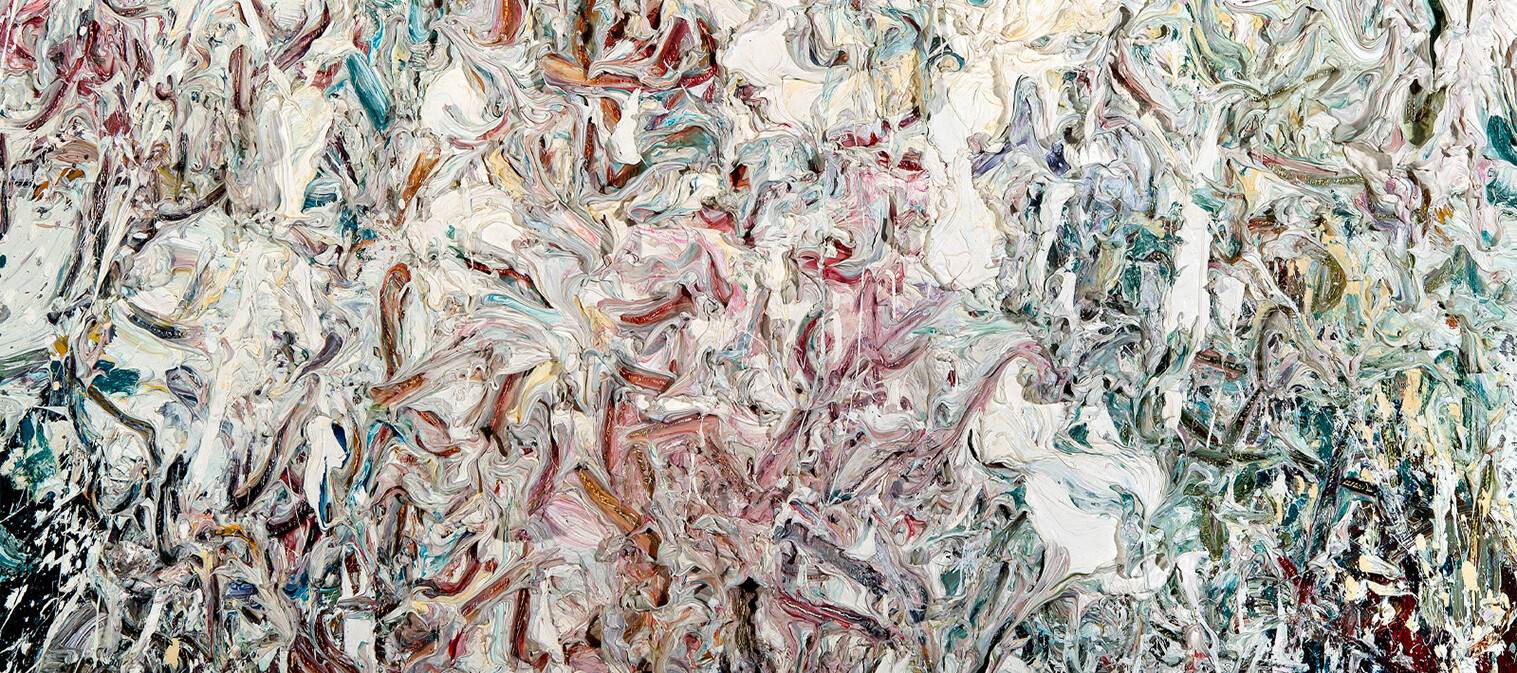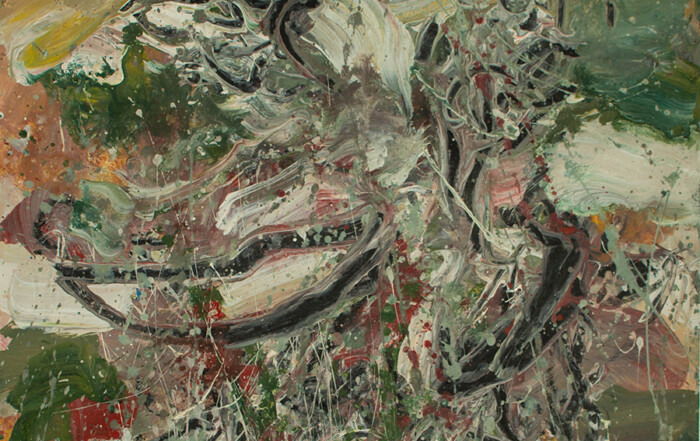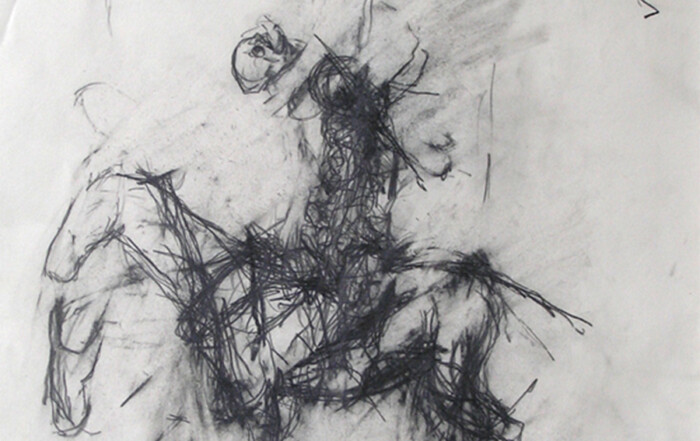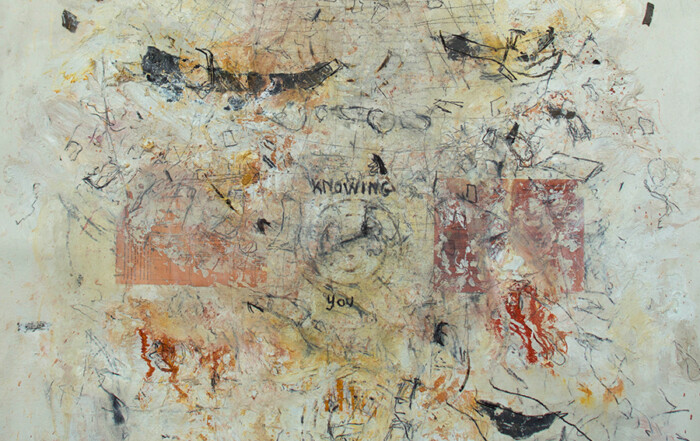by trinkarav
Share

There is an orange piece of paper on the windowsill. It says; “Dog in Kitchen,” There is a bit of duct-tape on the top. It is designed for reuse and it looks like everything else on the farm – well worn. They used to keep the dogs in the kitchen; that is until Rufus showed up. Rufus was a very large black lab. He was a genius. He could open a can of food with his teeth. He was able to open most doors, but perhaps, his greatest trick was that he could make himself invisible. He could go totally quiet and flat in the dark place under the kitchen table. His eyes had a way of being open enough to see, but not enough to draw your attention. His patience was endless. He would wait for however long it took for people to leave. What no one ever saw, and what strains credulity, is how fast he must have moved when the time was right. This large lump of laziness and inertia, transformed into a dog of action. They talk about zero to sixty in one minute. That was nothing on Rufus.
When one of us returned to the kitchen, to find the opened cans, the tatters of the cereal box, the broken plate on the floor, the cookie crumbs, a total disaster area, it would appear that he had not moved, that he had slept through the whole thing. Your mind would do a double-take; the evidence was clear, yet his innocence was palpable, it radiated from him like a warm heat. Nothing computed. That dog could mess with your mind.
“Dog in Kitchen,” was written for other dogs but it might have become his epitaph, Rufus died from something he ate. Rufus and Obie, his brother Labrador, would scour the woods looking for carcasses. Margaret, my sister-in-law, called them “the Men in Black.” Two sleek black athletes, noses down, at full run, circling the perimeter. Doing honest work, for once. Food was a fulltime job.
As an artist I am on the lookout too. Plans fall apart. I learn to work with random events. I find things where I least expect to. The cracks on the ceiling become the tree branches. What scrap of paper will become my epitaph? A next signpost? My next painting? It feels like I just trip over what I need next. Work in the studio feels like that. It always feels like chance. It doesn’t compute. How the scrap of paper, the slip of the hand, the wrong turn, how it all plays out. How the unexpected can bring in a new coherency, a new unexpected relationship. It seems to come from the whole crazy chaos of it all. Where the seed falls. Which rabbit the hawk kills. A journey through a painting can be like that. Crazy turns. Impulsive decisions, unexpected actions. At other times it just moves and I try to keep up. But usually I wait like Rufus. Patient. The people will leave, the voices in my head will stop. Opportunity will come. Lie low, Stay present. Don’t move a muscle in my mind. Neutral. Still. Be the floorboard. One with the black, with the dark. A hunter waiting, invisible, alert.
Then when the painting comes, it comes in like crackling across the surface of a frozen pond. It comes in fast, spreading over the canvas. It seems to come from somewhere else – a law unto itself – it has the quality of wildness. It has the force of nature. One or two movements of the brush bring it in like the patterns of falling dominoes. It is total gift – a rush. This is the secret joy of painting – that we will be met. This is what will bring us back, under the table, waiting. Can I do it again? Have the gods not figured out my ruse? Will they put me out of the kitchen? Will they make a new sign? “No Dogs Allowed.”
Bobcat
All the ash trees on the farm are dead. Although indigenous to the area they have been wiped out by the invasive Emerald Ash Borer Beetle. A large double trunked Cherry was leaning into three tall dead ash, the roots of the cherry rotting away. The entire group hanging over a structure on the farm. I studied it for days, thinking of ways to get them down. I could find no safe solution and the tree service arrived yesterday. Two Cherokee, one older man, small and light, worked the Bobcat, the other, tall with a pointed beard, worked the long chainsaw. The bobcat was small and compact, outfitted with a bulldozer and a long arm with a tree grabber on the end. They worked their way in through the low growth tangle of bushes with systematic precision to get the machine in position under the leaning trees. They worked it so the bucket of the grabber was up against the heavy trunk of the cherry. One by one they pushed the trees away from the farm structure. The machine made short work of it and within a few hours all the ash was down along with the cherry: the small area of forest transformed – the long trees laid out in a tangle on the ground.
The bobcat had pushed back on nature’s threat. It seemed like an easy win. Technology and the foresters’ skills had solved our problem. In painting and drawing images there are also ways of solving the problems that come up.. Photographic and computer programs can give us multiple options. Technology has come a long way from the optical use of mirrors and projection, the old secrets of the artist, used by some artists for hundreds of years.
Jack Lord, the writer, sat for a portrait by Alberto Giacometti. It took a long time. He ended up writing a book about the experience. He was amazed and sometimes horrified watching Giacometti wipe out what he had done, and begin again, over and over. He could not understand what the artist was looking for as he wiped out what appeared to the sitter to be powerful portraits. When he asked, Giacometti said he just wanted to paint what he saw. Giacometti’s struggle is well documented, his pushing against the stubbornness of the material with persistence and intensity in his quest to capture the complexity of “seeing.” It became a lifelong quest working with paint and clay. In the end he said of this struggle.“I do not know whether I work in order to make something or in order to know why I cannot make what I want to make.”1
I can imagine he might have agreed with Philip Guston who wrote to his friend Ross Feld.
“The nervousness of the maker is what one has – very little else – and even the “else” is rancid – like old seaweed clinging on. Advice to myself – make no laws. Do not form habits. You do not process a style – you have nothing, finally but some “mysterious urge” to use the stuff – the matter….” 2
Other than his nervousness, his mysterious urge, he had very little else to help him in his work. And even this “else” was rancid – all the technological tools were of no use when he wanted to draw what was in front of him – to draw a boot or a kettle. He chose to limit his tools – to forgo the technology that was available. It was as though the difficulty itself – Giacometti might say, the impossibility – of drawing the boot with these simple tools, was the reason for the action. The practice was purposefully restricted to hand, eye, pen and paper. All technology, the history of drawing and even his personal life of working with these materials, were no help – they were rancid bits of seaweed clinging on – to be discarded, scraped off. It is a strange and stubborn stance. No interest in holding the pencil up to measure the proportions, no technique to serve the task. It was as if he was making himself look for the first time upon the boot – as if he was the first person to make a drawing. It was a search for innocence, an encounter free from the programming of history and culture. Using only ancient and very simple technology, it was as if he sought to stand in forgetfulness —calling on some other way of doing things – another source of instruction. It was as if I had approached those trees leaning over the building with an ax and maybe a handsaw. I thought of the ancient people who had inhabited these forests and how they might have handled the situation. Would there have been a better outcome without these modern technologies? The impact on the integrity of the forest would certainly have been less violent. My relationship with those trees would have been closer had I worked the scene with hand tools, taken the time – taken the risk. The historian David Summers, repeats a phrase from 16th century theorist Gabrielle Palcotti, “Art is a remedy for the defect of distance.”4
Our minds have a distance-making function. It is built in. The order we create out of the flow of information coming to us from the vibrational energies of the universe, becomes the reality we inhabit. It is well known that animal perception is very different. When we name a tree, identify it, we separate even further from the experience of being with that tree. Our minds are not designed to keep us in close attunement to the vibrational reality in which we actually live. There are however doorways to seeing past the confines of our initial perceptions. This is what Giacometti and Guston were doing in their work. They struggled against the known and the named to return to a more expansive vibrational experience of reality. To do this they had to discard the gifts of the technologies that have been the achievement of scientific exploration, that building on the extraction of mathematical principles from deep inside the workings of the universe, we have created a world to serve our needs. But as is now clear, it has come at a cost. The scale of the cost to our environment is clear. The spiritual costs are perhaps more hidden – our sense of belonging – our sense of connection – are all part of the failure of culture to connect us up in deeper ways to each other and the world around us. When Philip Guston picked up that pen or pencil to draw the boot, he was seeking to establish contact and regain that ability to see. His drawings came out with a crudeness and directness that many found appalling. They shocked us. He had broken through a screen of distance.
We talked with the two forestry workers about their ancestors. The older man said he had a box of papers handed down to him from his grandmother. He kept it shut because the documents were so fragile. He talked of his people working the skyscrapers in New York, walking the narrow girders high up above the city – no safety ropes, no harnesses – just open sky all around. He said you couldn’t look down – you couldn’t do it if you looked down. The conversation swung back to the Bobcat – how he preferred a different model – this one was awkward – how you can get them second hand with a full warranty. Yes, we want one for the farm – that is an old dream – almost a running joke – that kind of money. Our minds in full tilt
from the wonder of those Cherokee construction workers silhouetted against the Manhattan sky, caught in those old photos – legends, heroes now – star athletes from the history of construction – back down to imagining what life would be like on the farm with our own Bobcat. The old man’s eyes lit up as he gave his recommendations and shared his knowledge. He worked that Bobcat like it was an extension of his own body – there was even a softness and subtlety in the way he got that machine to brush things aside or select a particular limb to grab and pull. There is an effortlessness in the strength of the machine – no hesitancy in how it grabs and lifts. The metal pistons are well oiled and smooth – the leavers in the cab are finely calibrated to open and turn the grabber at the end of the arm. A move of the hand on the leaver becomes an iron grip on the trunk – an arm breaking, trunk breaking grip. You can pull those small trees out by the roots – the sounds of cracking and snapping echo in your bones. It is a long dance, this dance with technologies; seductive and complex. It is a long way from an ax to a Bobcat and even further to a self propelled car and the implications are different. The separation has a long scale and a long history.
There is a saying in the tribes of Papua New Guinea: “knowledge is just a rumor until it lives in the muscle.” 6 Both Alberto Giacometti and Philip Guston, like the Cherrokee with the Bobcat, had plenty of knowledge in the muscle. It gets there in the daily doing – the handling of materials – the grip of the pencil, the pinch into the clay – that close in contact where the connections catch hold – where thought turns physical and the line comes alive – the clay starts to hold energy and become animated. This is the place they could trust – ground on which they could stand. This is what lay behind Guston’s urge to use stuff – the matter. This was where the embodied knowledge, the impulse and the material could meet the vibrancy of now – the ever-changing vibration of experience. Here in the paint he could find “an umbilical cord between himself and the painting”7 – a channel for the knowing in his muscle that could get to his brush. He said he would get maybe twenty minutes of this direct contact, that was it. Then off to the movies – out-a-there.
For Giacometti it was where the will to make ran into the stubborn resistance of the material and the constant changing nature of seeing. This is the wall of impossibility that Giacometti ran into in his efforts to draw what was in front of him – those few patient sitters who agreed to be his models year after year. John Berger, pulling from his personal experience of drawing, wrote:
Nothing else in the world quivers with such complexity as the living human face, and its quivers are like waves crossing the sea of a lifetime.
The drawing at its best is a record of the encounter and can never be an accurate rendition, a pinning down of the flux of sight. It is here we find the strange alchemy that manifested in Giacometti’s art. Asked late in life, “What shall we do with these sculptures? Take them to the museums?” “No,” he said, “bury them in the ground so that they can be a bridge between the living and the dead.” 8
Something got cracked open there in his studio, in his engagement – some doorway to the other side. The bronze appears to move and change before our eyes.
Out of the persistent ritual of doing, the daily task, the scheduled sittings, a different conversation creeps in. It becomes an agitated, cranky kind of meeting with spirit. You can’t sit with someone, watch someone for that length of time without coming into contact with their spirit. Not if you are Giacometti. The problem is you can’t draw that any easier than you can draw light around the eyes. Maybe it is the same problem. They are inseparable. It all has to be found, a residue that shows up despite your efforts – right there when you are about to give up – an unexpected gift. Something you must honor. Bury in the ground – not something you can put your name on, put in a museum, build your reputation on – not a worldly matter – a bridge between the living and the dead.
The constant rework and redraw of his paintings – the hours and years of working – all speak to this hunger to know why he could not do what he wanted to do. It became an existential struggle to understand the place where identity and will, ends. It was a battle to place human life in the context of the silence all around. The bridge was constructed of matter – of the stuff – material that inhabits a longer timeline than we do – materials animated by his engagement. When I encounter his work now I can feel that strange combination of his effort and his nervousness, his close in contact, with that silence.
I think of those aging documents in the box the old man had inherited from his grandmother. The slow deterioration of the thin paper – these messages from past lives – maybe letters or official documents, possibly a newspaper article. He will give them to his grandchildren, he said. Who knows what will become of them. Like his skill with the Bobcat, his knowledge of the felling of trees, maybe there are stories to pass on or a turn of phrase he liked to use, that will stick in memory, become part of what he leaves behind. He had said about those construction workers high on the iron girders, it wasn’t that you didn’t look down, it was that you looked up. You held yourself in the sky above you, not the air below you. You elevated your body to that height so the girder below your feet was the ground. Below that was of no concern. You inhabited what was in front of you and the great dome of the sky above. You never call up to a man on a girder above you – make him look down. There is an old Ojibway saying; “sometimes I go about pitying myself and all along my soul is being blown by great winds across the sky.”9 Look up – good idea. Go where the soul is.
After they left the farm I saw the two of them sitting quietly, on the side of the road, by their truck with the Bobcat all loaded up and strapped down. It was a beautiful spring day and the job had gone well. They were content, quiet. It was Saturday.
In the art of Giacometti and Guston I feel the same quiet, an embodied closeness. I feel the presence in Guston’s boot and kettle. They have physical weight that creates a dramatic sense of mass and inertia. They become matter – stuff – a great heavy pile. They hold stubbornness and resistance to time and interpretation. They just are. They seem to me to be a return to the preverbal – to the intimacy of contact before naming. When I get myself here, in this close-in wordless contact with matter, I find it is a place of extraordinary energy and possibility. I am taken to the source – the source of my creativity. Here I find instruction and coherency that prefigure my mental constructs. Gaston Bachelard in his book The Poetics of Space, wrote:
The mind is able to relax, but in poetic reverie the soul keeps watch, with no tension, calmed and active. To compose a finished, well constructed poem, the mind is obliged to make a project that prefigures it. But for a simple poetic image, there is no project: a flicker of soul is all that is needed. 10
He goes on to say: “the poetic image is under the sign of a new being. This being is a happy man.” Roland Barthes put it another way: “The brio of the text is it’s will to bliss.”11
Giacometti’s sculptures are like volcanic crustation – outgrowths of nature. They too, are matter. Although they are animated by life and human likeness they speak more to the melting of metal – to the elemental power of heat. They carry more the history of the earth than the transient moment of seeing. They are residue – a deposit left from the engagement – from the final surrender of will and its partner, identity. The action, the struggle, the effort of the artist is now less present – less evident. They put us in a longer sense of time. Here our technologies, with all their power and reach, take their place in the planetary field. They stand dwarfed by the power of an earthquake or flood. I stand with the quiet that settles on the forest after the felling of the trees, and on the foresters seated by their truck after work. Here I feel better served by the pencil in my hand and my clay in the fingers than by the reach and power of technology..
The defect of distance separates us. It puts me outt of relationship with the children growing up in the countries where we conduct drone warfare — out of relationship with all the suffering that results from our actions. It leaves me taking no responsibility. It leaves me uninformed and out of touch with the realities of life on this planet. It leaves me in the dark and ignorant of my projections, ruled by my anxiety rather than my wisdom. The defect of distance and the building of that distance is at the heart of consumerism. It is the grand illusion that allows for the domination and exploitation of the global economy by the few – the very rich. It comes at a cost we cannot afford.
This illusion plays out not just in our politics and our culture, but more profoundly in our beliefs and our schooling. That is why a return to direct contact is a radical and essential action – we need a clean scrape of the old seaweed clinging to our sides. It is a return to a place where we get to examine how our will, and often our aspirations, fail us.
“The soul,” Roger Housden writes, “is a dynamic constellation of energy and silence.” 12 The silence past the chatter of the mind, where the energy and vibrancy of the view above our heads – out into the dome of the sky – returns us to sanity and connection. As Jane Hershfield wrote in a poem about a tree growing close to the house, bridging the gap between its natural quiet and the daily rattle of noise. “Already the first branch tips brush the window. Softly, calmly, immensity taps at your window.”13




